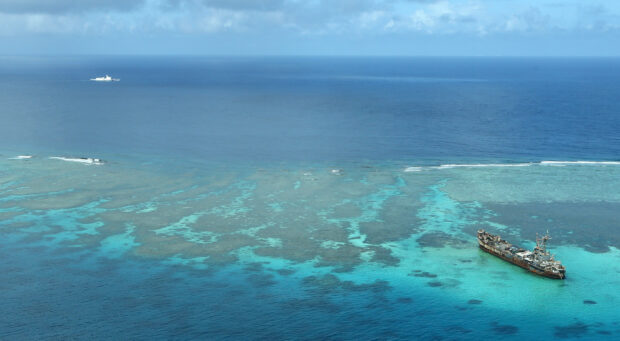Eyewitness to cat and (wet) mouse game in WPS

PUERTO PRINCESA CITY — In the latest resupply sortie to the BRP Sierra Madre, a Chinese coast guard ship nearly smashed into a wooden boat of the Philippine Navy manned by a crew led by Lt. Jg. Darwin Datwin.
“They were just less than 5 meters from the boat’s starboard and we had to veer left to avoid a major disaster,” Datwin said, describing the Aug. 5 cat and mouse game in the waters near Ayungin (Second Thomas) Shoal west of Palawan.
“It was dangerous because the boats are made of wood. If they get rammed, we don’t know if the boats could sail back,” Datwin told reporters on Thursday. “What they did was very endangering.”
Datwin and his men were eventually able to maneuver the 24-meter Unaizah May 1 (UM1) to evade the much larger China Coast Guard (CCG) vessel that had tried to block its path to Sierra Madre where it delivered fresh provisions for the sailors and Philippine Marines manning the ship.
The partner boat, UM2, was not so lucky. It was unable to complete its mission and was forced to turn back after it was blasted with a water cannon from another CCG vessel and had to sail away.
Each of the supply boats was escorted by a Philippine Coast Guard (PCG) ship. However, UM2 and its escort were “corralled” by large CCG ships and Chinese maritime militia vessels disguised as fishing boats. Not far away were two Chinese naval warships.
The Philippine government strongly condemned and officially protested to Beijing the actions by the China Coast Guard (CCG) to block supplies from reaching Ayungin and the rusting Sierra Madre that is marooned there.
The World War II-era Sierra Madre was deliberately ran aground on the shoal in 1999 to serve as one of the country’s outposts in the West Philippine Sea, waters within the country’s 370-kilometer exclusive economic zone.
Supplies drenched
The UM2 was led by Lt. Ramsey Gutierrez, who was on his first resupply mission to Sierra Madre.
He said that they were prevented from reaching the ship as they were “boxed in” and surrounded by CCG and Chinese maritime militia vessels, giving them little room to run through the gauntlet.
“Our maneuverability was restricted. There were two militia vessels on the starboard and port side, left and right. The CCG was behind us. There was no way for the boat to sail to its intended track,” he said.
After repeatedly ignoring the Chinese coast guard’s orders on radio to turn back, the UM2 was blasted with powerful jets of water fired by CCG 5201.
“The food supplies we were carrying like rice, vegetables and meat got drenched,” Gutierrez said.
He said that while being drenched, he and his crew remained “composed” and maintained radio contact with their superiors on what to do to safely navigate the boat in the situation it was in.
The PCG reported that the UM2 was bombarded for almost two hours by the CCG ship.
Why wooden boats?
After getting out of range of the water cannon, the UM2 sailed away from the shoal and met up with PCG ships MRRV 4409 and MRRV 4402. They were later joined by UM1 about 33 kilometers northeast of Ayungin.
All the Filipino vessels were “surrounded on all sides” by the CCG vessels and the Chinese maritime militia boats from a distance of 50 meters to 80 meters, the PCG report said.
By 6 p.m. on Aug. 5, they sailed back to Palawan without further harassment from the Chinese. They arrived around 3 p.m. the next day at Ulugan Bay on the western side of Puerto Princesa, about 325 east of Ayungin.
The Navy deliberately uses small civilian-type wooden boats in these resupply missions, not regular naval vessels, to avoid sending a wrong message that they were on a military mission. But for the Chinese, the boats’ configuration didn’t matter as they were determined to stop any supplies from reaching the men on the Sierra Madre.
Another officer who was on UM2, Lt. j.g. Richard Lonogan, who was familiar with the Chinese actions against the Philippine supply boats in the past, said their morale was high and did not waver.
The water cannon attack came “in the line of duty” and could not dampen their spirit, he said.
“In terms of morale, there is no higher source of morale than the honor of serving the nation,” Lonogan said. “That alone gives us high morale.”
RELATED STORIES:
Eyewitness at Ayungin: Chinese force, PH grit
China warns PH troops at Ayungin Shoal: Don’t make trouble
Plan was to ground more ships vs China moves — Mercado
Joint patrols as escort for Ayungin trips pushed